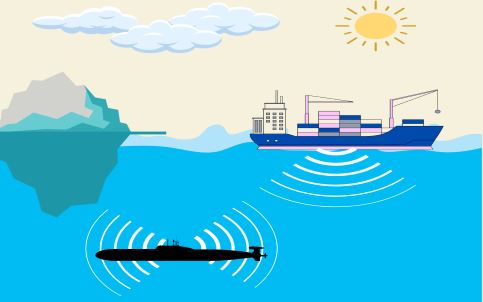Find more at Tech Savvy Youth's Blog. The following article is a TSY Blog post regarding the technology of SONAR. Years have passed since humans stopped using wooden sailboats and fancy ancient caravels that were developed and used by European colonizers back in the 18th century. The marine technology has seen some profound changes that highly shaped modern vessels- From massive white sails to diesel propulsion systems (DPS), from caravels to diesel-powered cargo ships and ancient naval frigates to multipurpose aircraft carriers. Imagine next summer going to Hawaii on a 16th-century caravel (An ancient portugese sailboat) and waiting for months, stranded in the lonely ocean for sea winds to blow. Thankfully, you don’t have to do this anymore!!
The early 1900s saw a major invention which facilitated efficient and stronger sea warfare, this nes technology was called Sound Navigation And Ranging (SONAR). Developed by Canadian scientist Reginald Fessenden in 1913, SONAR was a revolutionary invention for World War 1. Although Fessenden got a patent for developing the modern SONAR concept, the idea of using ultrasonic sound waves to navigate in water is believed to be introduced by Leonardo Da Vinci in the 1490s i.e., centuries ago even submarines and diesel-powered ships were invented. In this period armies of several dominating nations focussed on strengthening their navies and this invention helped them succeed in naval warfare. The idea spread like wildfire in Europe and America, and soon numerous countries developed submarines and ships that used SONAR to navigate through water and determine possible threats. SONAR was a major factor that eased Submarine warfare in both the world wars and almost every battle which involved the navy.
SONAR works on the concept of ultrasonic sound waves. A Vessel equiped with this technology consists of a transmitter and a receptor. Sound waves are transmitted through ocean water in all directions. These waves can travel more than 300 miles and have a speed of 1.5 x 10^3 m/s. Once they collide with an object they reflect and echo back toward the home-vessel. This echo is captured by the receptor thus confirming what is called a 'SONAR Contact'- which basically means that the SONAR found something. Sonar engineers and trained professionals analyze these echoed sound waves to pinpoint possible threats and other marine vessels. During naval combat, this process is done in moments by the highly trained crew. It plays a vital role in identifying and confirming enemy positions or incoming torpedoes (programmed missiles fired by submarines that navigate through the water to a pre-defined target). It is incredibly advantageous in detecting icebergs and sea depth as well.

Ultrasound waves used by SONAR to navigate in water
SONAR engineers and experts onboard vessels play a vital role in the functioning of this system. In a true scenario, a professional crew onboard a vessel can differentiate between different sound waves to understand the origin/nationality of submarines. This is important so that you don't blow up your own companion submarine/ship. They study the wave patterns and the echoes to calculate rythm and measure the BPM. These engineers also take into account several sound-related aspects like tone, wavelength, pitch etc. while making speculations about their surroundings.
Even though ships use SONAR, submarines have so far been most endowed by this invention. As it is next to impossible to propel a submarine without SONAR. It is used by submarines to detect other vessels, torpedoes, calculate sea depth, detect marine mines, and supply efficient surveillance. Submarines do not have any medium of visibility, SONAR is all that the crew has got to survive in a gigantic chunk of metal 200 meters underwater. It is because the pressure at such depth is high compared to that at sea level, thus it will crack open any windows or other means of visibility, minutes after the submarine dives down. Also, after 100 meters of depth, the ocean is filled with darkness and there is no chance of visibility anyways.
Apart from naval usage, Sonar is also Highly efficient for commercial purposes like spotting schools of fish underwater. Few fish and seafood companies have started using it in their boats to locate fish. Fishing is a tedious job. At least for me! I am sure the commercial fishermen dont wanna spend hours finding the fish they are looking for. Marine Excavation teams also use SONAR to locate shipwrekcs and other submerged objects. Geologist study trenches, under water hills, presence of coaral reefs and etc. through this technique.
Even though being a revolutionary technology it has negative consequences on marine life. Questions have been raised by several ecologists and marine professionals on the effects of ultrasonic sound waves on fishes and other sea creatures. Studies have shown that active SONAR can lead to the stranding of sea creatures. Blue whales and beaked whales are the common victims of these high frequencies. Navies conduct drills and excercises which use mid-frequency Sonar that is a major reason for the deaths of sea cretures. Most of these creatures use sound waves to locate their prey and communicate with other creatures. Loud sound from SONAR obstructs these low frequency sounds of animals and end up standing them. However, many alters have been made by navies around the world to minimize its effects on the marine world. Although some environmental issue sustain, SONAR has been a game-changer in warfare and international trade.
Signing Off,
Atharva Saraf